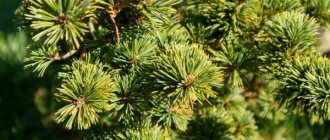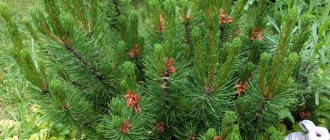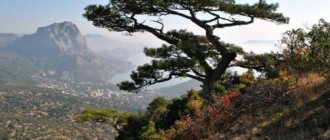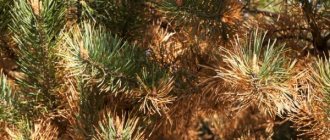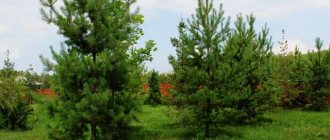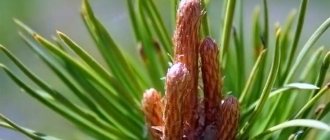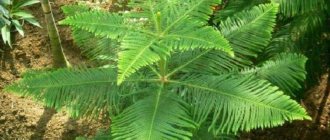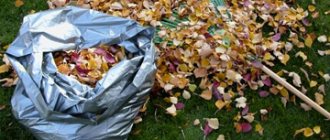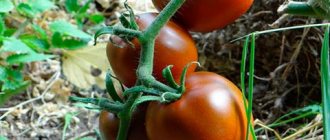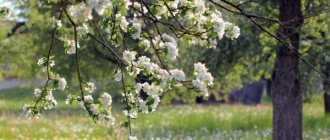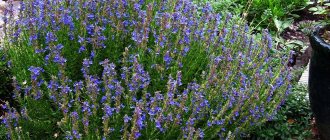Bushes and trees
0
401
Article rating
Kira Stoletova
Ornamental Himalayan pine is also known as Wallichiana pine (pinus Wallichiana) or Griffith pine (pinus Griffithii McClell). It was named after the Danish surgeon and botanist Nathaniel Wallich. In 1823, the plant in a cultivated form was brought to England by the English breeder E. B. Lambert. Later, ephedra began to be grown in Russia.
Himalayan Pine - growing a fluffy beauty
Brief information about the species
- Color : gray or bluish-green needles with a silvery tint.
- Height : about 23-25 m.
- Crown width : 20 m.
- Planting Features : Sunny place with diffused daylight. Planting pattern: 4x4.5 m.
- Growing regions : in its natural environment, pine grows in the eastern part of Afghanistan, western China, northern Myanmar and Nepal. Distributed in the Himalayas. Not suitable for northern areas.
- Immunity : good winter hardiness, high resistance against fungal diseases.
- Life expectancy : about 300 years.
Himalayan Pine - growing a fluffy beauty
Ornamental Himalayan pine is also known as Wallichiana pine (pinus Wallichiana) or Griffith pine (pinus Griffithii McClell). It was named after the Danish surgeon and botanist Nathaniel Wallich. In 1823, the plant in a cultivated form was brought to England by the English breeder E. B. Lambert. Later, ephedra began to be grown in Russia.
Himalayan Pine - growing a fluffy beauty
general characteristics
In its natural environment, Himalayan pine grows in eastern Afghanistan, western China, northern Myanmar and Nepal, and is also common in the Himalayas.
The plant is successfully cultivated in almost all CIS countries, with the exception of the northern zones. They are grown in Ukraine, Belarus, in Batumi and Sochi. Suitable for planting in central Russia and southern Russia.
Description of external parameters:
- in the wild, the height reaches 50 m, the diameter is 20 m, in private and industrial areas the dimensions are 23x20 m;
- the crown is loose, wide-pyramidal, consists of long flexible branches that begin to form at the very bottom of the trunk;
- the needles are very long (up to 20 cm), bluish or bluish-green with a silvery tint, thin (1 mm), collected in bunches of several pieces, stored on the tree for 3-4 years;
- in young specimens the bark is smooth, dark gray in color, in adults it takes on an ashy tone, contains numerous detachments and cracks;
- young growth is bare, light green in color with a sheen;
- the cones are red or light brown, 32x7 cm in size, cylindrical in shape, in some conifers they are straight, in others they are curved;
- large seeds - about 5 mm in length;
- the root system is branched, located close to the surface, the central rod can reach 1.5 m in depth.
This variety is long-lived - life expectancy is about 300 years.
Winter hardiness is good - adult specimens are able to withstand temperatures down to -25-30°C without insulation. But in snowy winters, branches often break under the weight of snow. A prolonged winter thaw is also dangerous for this tree - the plant awakens ahead of time and freezes during return frosts.
Pine varieties
Species Griffith pine
| |
Schwerin pine Wiethorst
| |
Himalayan pine Nana
| |
Pine Densa Hill
| |
Zebrina pine
|
Features of cultivation
Successful cultivation of a crop depends on several factors - the quality of the seedling, planting location, soil composition, as well as further care.
Selection of seedlings
Pine likes to grow in windless areas
To get a plant with all the signs and characteristics of a real variety, you should contact a specialized nursery.
When choosing planting material, you need to adhere to some rules.
- Buy seedlings with a closed root system or in containers. Such conifers have a well-developed underground part, and during the process of transplanting to the site, the risk of its drying out and injury is eliminated.
- You should take specimens that are 2-3 years old.
- When purchasing, you must carefully examine the above-ground part - it should be alive, rich green in color, without black or red spots on the surface of the shoots and needles - these indicate infection with diseases.
- The optimal height of the seedling is 60-70 cm.
Preparing the site and soil
The site for planting should be selected based on the following requirements:
- It is worth planting in a place where there is no wind, preferably on the south or south-east side, along a fence or next to an outbuilding;
- a bed with diffused daylight is suitable, so the plant will be protected from the scorching spring sun and will not suffer during the February thaw;
- The soil needs to be light, loose, non-alkaline without stagnant moisture.
The place for planting is prepared two weeks in advance - freed from plant debris and weeds. To improve the structure of clay soil, you need to add a couple of buckets of sand; if you plan to grow on sandy loam, you should add the same amount of clay.
The acidified area is sprinkled with calcite, dolomite flour or chalk at the rate of 300 g per 1 m².
Landing technique
For full growth and development, Himalayan pines require sufficient space: the optimal distance between seedlings is 3-4 m, the distance in a row is 4.5-5 m.
They dig holes 2-3 times larger than the size of the tree’s earthen ball. Fill the bottom with drainage made of pebbles, crushed stone or brick chips. Then half is filled with a nutrient composition of sand, peat and turf soil (2:1:1). Lower the plant so that the root collar is 5-6 cm above the soil surface.
The voids are filled with soil, compacted, and watered abundantly through holes dug at a distance of 50 cm from the tree trunk area. After this, mulch with a thick layer of pine sawdust, wood chips or peat. Mulch will protect the roots from drying out and hypothermia.
External description
Griffith pine in its natural environment reaches a length of up to 50 m, and a girth of approximately 20 m. The height of the cultivated plant is only 25 m.
- Young trees have dark gray bark. In mature plants it is ashy. In addition, with age, it begins to crack and detachments appear.
- The crown is blue-green with a silver tint or bluish color. The shape is wide-pyramidal.
- The branches are loose and begin to grow almost from the base of the tree. They form needles, the length of which reaches 20 cm and the diameter - 1 mm. The needles are collected in bunches. Every 3-4 years the needles are renewed, that is, the old one disappears, and a new one grows in its place.
- The cones are cylindrical, elongated (32*7 cm in size), light brown or reddish. They can be either straight or curved.
- The seeds are large in size. Their length reaches 3.5 cm. The wing is elongated.
- The root system is located close to the surface. The length of the main rod reaches 1.5 m.
Basic care
All care for this crop comes down to carrying out several mandatory activities.
Watering
In the first years of life, young pines need regular and frequent watering, especially in dry summers - at least 5 times per season. Take 2 buckets of water for one seedling.
Abundant moisture is required in early spring before the buds awaken and in the fall a month before the onset of stable frosts. Consumption per plant - up to 40 liters.
Young conifers respond positively to the sprinkling procedure, which saturates the crown with moisture and prevents the appearance of parasites. Irrigation is carried out every week in the summer in the evening hours to avoid the risk of burning from the sun's rays.
Loosening and mulch
Good care will keep the tree healthy
After each watering, the soil is loosened superficially; it helps maintain its moisture and breathability. This manipulation is combined with weeding the rows and removing weed sprouts.
Finally, the tree trunk area is mulched with peat or pine sawdust, which protects the roots and soil from drying out and also prevents the growth of unnecessary vegetation.
Feeding
Complex fertilizers, applied twice a season, will help stimulate development and increase immunity against diseases.
In early spring, nitrogenous preparations are used (a solution of urea, nitrophosphate or ammophosphate at the rate of 30 g per 20 liters of water). A bucket of nutrient liquid is poured under one tree. This feeding promotes intensive growth of young branches.
At the end of July or at the beginning of August, pine trees are fed with a mineral composition: superphosphate and potassium nitrate - 30 g per 10 liters of water. These components strengthen the root system, increase frost resistance and help preserve the decorative appearance of the tree until spring. 5 liters of working solution are poured under one copy.
Trimming
This plant tolerates shaping haircuts well. Light pruning of shoots is allowed - by a third of the length; if you trim more, the tree may not survive the stress and die.
To form a thick and lush crown, 30% of the current year's growth is cut off in September.
Sanitary pruning will be mandatory to remove all branches damaged by winds, frosts and diseases. The cutting is carried out obliquely with a sterile knife or pruning shears. To avoid infection, the wounds are irrigated with a solution of copper sulfate, then covered with garden varnish or powdered with charcoal.
Preparing for winter
Young Griffith pines need good insulation, especially when grown in regions with changeable weather conditions - the Moscow region, Leningrad region, mid-latitudes.
The shoots of this variety are very fragile, so you should not use twine or rope to tie it to the central conductor. The above-ground part is carefully wrapped in burlap. Such a shelter will protect against freezing, excessive snow and sun rays in early spring.
Seedlings wrapped in burlap will have good access to fresh air.
Some gardeners use another shelter - spruce branches, which are laid on a pre-arranged frame.
In addition to insulating the crown, it is necessary to mulch the tree trunk area with peat or sawdust.
All work to prepare conifers for wintering is carried out in late autumn, when the temperature drops to -5-10°C.
Landing
A place protected from the wind is suitable for planting.
How the plant takes root and how actively it grows depends on several points:
- seedling quality;
- places on the site;
- type of soil;
- tree care.
Selection of seedlings
Only a high-quality seedling will be able to take root on the site and begin to develop normally. When purchasing raw materials, it is recommended to adhere to several rules.
Firstly, purchase specimens with closed roots. This will prevent injury to the root system when planting.
Secondly, it is better to choose a plant whose age is 3-4 years and whose height is 60-70 cm. In this case, the chance of successfully taking root increases.
B-3, carefully inspect the tree for damage and foreign stains. If there are any, you should not make a purchase. The fact is that this may be evidence of pathology or the presence of parasites.
Preparing the site
Himalayan pine should be planted where there is protection from the wind. Usually this is an area next to a fence or house.
The place should be located on the south side. In this case, the pine will receive enough sunlight for normal growth and development.
To protect the tree from winter thaw and blinding sun, it is recommended to place it under diffused light.
14 days before planting, it is necessary to clear the area of weeds and thoroughly loosen the soil.
- If the plant will grow on sandy loam, it is recommended to add a couple of buckets of clay.
- When growing on clay soil, the soil is mixed with two buckets of sand.
Next, the soil needs to be fertilized. For this purpose 1 sq.m. cover with 300 grams of one of the fertilizers: chalk; calcite: dolomite flour.
Each of these fertilizers saturates the soil with calcium, due to which the pine takes root faster.
Technology
In order for the seedlings to grow and develop normally, it is recommended to place them at a distance of approximately 3-4 meters from each other. If you plan to plant several rows of plants, then the gap between the strips should be 4-5 m.
When planting pine trees, follow this algorithm:
- form a depression the depth of which is 2 times the length of the roots;
- fill the bottom with broken bricks, pebbles or crushed stone so that moisture does not accumulate here (it negatively affects the root system of the tree);
- lay a mixture consisting of turf soil, sand and peat in a ratio of 1:2:1 so that the soil reaches half the length of the recess;
- place the seedling so that the base is 5 cm above the surface, add more soil and compact it;
- Irrigate and mulch the soil with sawdust or peat.
Reproduction
Pine will decorate your garden
You can grow Himalayan pines from the seeds of an adult and healthy tree over 10 years old.
Planting material is collected in the fall (late September or early October), when the cone is fully ripe and produces seeds. They are dried at 40°C and stratified for a month in the refrigerator in wet sand.
Sowing is carried out in seedling boxes or containers filled with drainage and a nutrient mixture of sand and peat (1:1). The seeding depth is 1-1.5 cm. The plantings are irrigated with warm water, covered with a transparent film and placed in a cool place with a temperature of 18-19°C and diffused daylight.
The germination process can last from 2 to 3 months. To prevent seedlings from dying, they need to be regularly moistened and ventilated every day. After the emergence of seedlings, the shelter is removed, watering continues, periodically loosening the soil and removing weeds.
Seedlings obtained at home are grown for another year. Transplanted to the site in the fall - in early or mid-September.
Using wood in landscape design
Due to its decorative appearance, Himalayan pine is widely used in landscape design. It is planted in parks, alleys, squares, along fences, in single plantings. It looks impressive next to plants such as spruce, cypress, magnolia, horse chestnut. Used to create bonsai.
Read more about the use of pine in landscape design.
Himalayan pine will decorate any summer cottage. It can be easily grown at home. To do this, you need to provide constant care for the plant, thanks to which the tree will grow beautiful and healthy.
Pests and diseases
Pine has increased immunity against many diseases and parasites. Provided good care and compliance with all rules of agricultural technology, even rust does not damage it.
The main reason for the appearance of diseases and harmful insects is thickening, lack of sanitary cutting, and the use of already infected seedlings for planting.
In case of rust damage, all damaged organs are removed, and the crown and soil around the tree trunk area are irrigated with Ridomil Gold or copper sulfate solution twice with an interval of 7 days.
When infested by spider mites, scale insects, sawflies or moths, insecticides are used - Actellik, Aktaru or Enzhio.
Description of the Himalayan pine, planting and caring for it
Among the wide variety of ornamental coniferous trees used in landscape design, Himalayan pine or Wallichiana occupies a special place. It has very beautiful and unusual needles. Many summer residents want to grow this plant on their plots. The main characteristics of pine and the conditions for its growth at home are discussed later in the article.
Botanical description of the tree
Himalayan pine is a tree 10–15 m high with an openwork pyramidal crown 3-4 m wide. The branches are located horizontally. The bark on young trees is smooth and dark gray, but with age it becomes darker and cracks. The needles are very long, about 15–20 cm, thin, collected in bunches of 5 pieces, bluish-green, stored for 3-4 years.
The cones are large, 15–30 cm long, cylindrical, light brown, strewn with a large number of resin drops. The seeds are ovoid, brown, 5-6 mm in size. The homeland of this ornamental tree is considered to be the wet and dry areas of the Himalayas at an altitude of 1800–4000 m, as well as the Tibetan and Chinese mountain belts.
Important! In favorable conditions, a tree can grow up to 60 cm in height and up to 20 cm in width per year.
Various names
The Himalayan pine or Wallichiana was brought to Europe from the Himalayan mountains in 1823.
It received its name in honor of the Danish and English surgeon and botanist Nathaniel Wallich, who studied the flora of India and Nepal.
In addition to this name, there are also others: Pinus wallichiana, Bhutanese, Wallich pine, Himalayan Weymouth pine (Hill Densa), Wallich pine, Griffith pine.
Landing
When planting Wallich pine, you need to choose well-lit places on an elevation, without direct sunlight and protected from the wind. It is also preferable to plant on sandy loam, fertile, well-drained soils.
Trees should be planted following this pattern:
- Dig a hole 1.5–2 times larger than the size of the seedling’s root system.
- Leave a distance of about 4 m between plants.
- It is advisable to add a drainage layer (broken brick, crushed stone, pebbles) 20 cm thick to the bottom of the hole.
- Mix chernozem with sand and peat in a ratio of 1:2:1 and pour halfway into the hole, making a mound.
- Place the seedling vertically on a hill, spreading the roots evenly.
- Sprinkle soil on top and compact it, leaving the root collar at ground level.
- Pour generously with warm, settled water.
- Cover the tree trunk area with mulch.
When planting Himalayan pine in acidic soil, you need to add lime to the soil mixture at the rate of 200–300 g per plant. Also, during spring planting, add 150 g of superphosphate to each hole, and during autumn planting, add nitroammophosphate, potassium nitrate or other potassium-phosphorus fertilizers.
Pine tree care
Caring for the Wallich plant plays a very important role in the further growth and development of the ornamental tree.
It consists of regularly carried out watering, fertilizing, loosening the soil, mulching the area around the trunks, pruning the crown, preventive measures against diseases and pests, and insulating young trees for the winter. Thanks to these actions, the pine will grow healthy and with a beautiful lush crown.
Find out also how pine differs from spruce.
Watering and fertilizing
Watering should be moderate, up to 2 buckets of water per 1 specimen, since excessive moisture (stagnation of water) can lead to rotting of the roots. Excessive drying of the soil also has a detrimental effect on the plant. It is recommended to spray pine throughout the year, increasing air humidity and preventing the appearance of harmful insects on the needles.
It is advisable to fertilize the next year after planting. In early spring, you need to dilute 10 g of ammophoska, 10 g of nitrophoska, 10 g of urea in 20 liters of water and water 1 bucket per plant. In the second half of summer - dilute 30 g of potassium nitrate, 30 g of superphosphate in 10 liters of water and add 5 liters of solution per tree.
We suggest that you familiarize yourself with information on how to propagate pine trees.
Loosening and mulching
After each watering (irrigation), you need to loosen the soil, preventing its compaction, as well as providing the roots of the plant with access to fresh air. At the same time, weeds that may contain pest larvae or fungi should be destroyed.
To retain moisture in the ground, the tree trunk area must be covered with mulch (sawdust, peat, etc.). This procedure will prevent the soil from drying out and prevent new weeds from growing.
Trimming
It is recommended to prune in the second year after planting. It can be done from spring to autumn. During sanitary pruning, remove all dry, damaged, diseased, bare branches.
During the formation of the crown, the branches should be shortened by no more than a third. To increase the density of the crown, 1/3 of the current year's growth is removed, while maintaining the shape of the crown.
Important! Griffith pine grows in almost all regions of the CIS countries, except the northern ones.
Possible diseases and pests
Himalayan pine, when properly cared for, is practically not exposed to the harmful effects of insects or diseases characteristic of coniferous trees. She has high immunity and can tolerate environments with polluted air. Very rarely susceptible to attack by pine aphids.
But if trees are not properly cared for, they can become seriously ill. As a preventive measure, you need to cut off damaged shoots and treat the plants with a 1% solution of copper sulfate.
Winter hardiness of pine
Wallich pine is a frost-resistant plant. It can withstand frosts down to -30°C. But very often the branches cannot withstand heavy snowfalls, blizzards and break.
Experts recommend shaking off snow from shoots to avoid their fractures.
The winter thaw also negatively affects Griffith pine, since this type of coniferous tree awakens very quickly after the first warmth and can die during the return of frost.
In addition, bright sun on a frosty day is destructive for plants, as a result of which the needles can simply burn from the reflected sunlight. Young trees require mandatory shelter for the winter. It is carried out at the end of autumn, when a constant temperature of -5...-10°C has established, and is removed in the spring, provided there are no daytime frosts.
The branches do not need to be tied to avoid damaging them. It is best to use burlap, thanks to which the plant can breathe and will be hidden from the sun. It will also be able to protect the branches from the weight of the snow.
Using wood in landscape design
Due to its decorative appearance, Himalayan pine is widely used in landscape design. It is planted in parks, alleys, squares, along fences, in single plantings. It looks impressive next to plants such as spruce, cypress, magnolia, horse chestnut. Used to create bonsai.
Read in more detail about the use of pine in landscape design. Himalayan pine will decorate any summer cottage. It can be easily grown at home. To do this, you need to provide constant care for the plant, thanks to which the tree will grow beautiful and healthy.
Source: https://fermer.blog/bok/hvoynye-derevya/sosna/vidy-sosen/14604-sosna-gimalajskaja.html
Reviews
Thanks to its good winter hardiness and excellent adaptive qualities in regions with temperate climatic conditions, many gardeners fell in love with this plant:
- seedlings have a high survival rate, with regular watering and fertilizing they develop a beautiful crown and delight with their decorative effect all year round;
- after several years of cultivation, trees do not need to be covered for the winter, which makes maintenance easier;
- Tall conifers with a lush crown are excellent for shading various garden areas in the hot summer, protect from the wind and decorate any place on the site.
Application in landscape
A tall evergreen plant is often used to decorate park areas and alleys. Planted singly in garden plots to decorate inconspicuous and problem areas.
Himalayan Griffith pine is an excellent option for the formation of forest and shelterbelts.
It goes well in group planting with chestnuts, evergreen cypresses and grandiflora magnolia. Some people use the tree to create bonsai.
Himalayan pine (Himalayan pine). Brief overview, description of characteristics, where to buy, seedlings
Griffith pine. Brief overview, description of characteristics, where to buy pinus griffithii seedlings
Himalayan pine Denza Hill. Brief overview, description of characteristics of pinus wallichiana Densa Hill
Himalayan pine: description, planting and care, photo
The Himalayan pine has several other names - Wallich pine, Griffith pine. This tall coniferous tree is found in the wild in the mountainous Himalayan forests, eastern Afghanistan and western China. Himalayan pine is valued for its decorative properties, so it is grown everywhere.
Description of Himalayan pine
Himalayan pine belongs to a species of gymnosperms from the genus Pine. This tree grows up to 35–50 m in height. The crown has a wide pyramidal shape with a loose structure. The branches are long, flexible, located horizontally, growing from the ground line. The decorative nature of the culture lies in the long thin needles.
The length of each needle reaches 20 cm, and the thickness is about 1 mm, so the needles are very flexible. The needles are collected in bunches containing 5 needles. Young needles resemble the needles of Scots pine, and with age the needles droop, which makes them look like willow. The shade of the needles can be bluish-green or bluish with a silvery tint.
Each needle grows on a tree for at least 3–4 years.
The cones after ripening become yellowish, their length ranges from 15 to 32 cm, width no more than 7 cm. The shape is cylindrical, slightly curved. The seeds are equipped with an elongated wing, the total length is about 30–35 mm. Pine blooms at the end of April, the timing varies from person to person and depends on the growing region. The buds ripen in the second year after flowering, around mid-October.
Young specimens are distinguished by dark gray, smooth bark; in older trees, it becomes covered with cracks, changes its color to ashen, and peels off in places from the trunk. The color of young shoots is yellowish-green with a characteristic shine; there is no bark.
The roots of the Himalayan pine are located in the top layer of the earth, the central rod reaches a length of 1.5 m.
The lifespan of the Himalayan pine in the wild is about three hundred years. Annual growth depends on growing conditions. Under favorable conditions, pine shows an increase in height of about 60 cm, the width of the tree increases to 20 cm every year, which is considered a good indicator for coniferous seedlings.
The approximate height of a tree grown in central Russia by the age of 35 is 12 m. In Crimea, a pine tree of the same age will grow twice as tall, i.e. up to 24 m.
Important! Himalayan pine has very fragile wood that cannot withstand heavy snowfall and wind, so the tree is not recommended for growing in northern regions with extreme weather conditions.
The Himalayan pine has a high degree of frost resistance; the crop can withstand temperatures down to -30 °C, but branches break under the load of wet snow or blizzards.
Himalayan pine awakens at the first warming, which can result in damage to shoots from recurrent frosts. If the tree managed to survive, it will not grow this season, since all efforts will be directed towards restoration.
Decorative needles can be damaged by bright sunlight in the winter and spring. The sun reflected from dazzling white snowdrifts is especially dangerous. It leads to needle burns.
Himalayan pine in landscape design
The main beauty of the Himalayan pine lies in its long, hanging needles. The tree is actively used for landscaping park areas; it can be planted in a flowerbed as a single specimen or in groups. Coniferous seedlings go well with rocky hills.
The dwarf version of the Himalayan pine, Nana, is popular; it forms a sphere up to 2 m in diameter. The needles of this subspecies are also decorative and droop with age like those of a willow, but the needles are much shorter than those of a tall tree.
The length of the needles does not exceed 12 cm. Another dwarf specimen with a spherical shape is Schwerinii Wiethorst. It was obtained by German breeders in the process of hybridizing Weymouth and Himalayan pine.
The crown of this variety is dense, fluffy, spherical, with a diameter of up to 2.5 m.
Dwarf species are used for landscaping garden areas; they look good both in single and group plantings; they are planted in rocky gardens, on hills, and in mixborders.
Planting and caring for Himalayan pine
In order for a seedling to be accepted and become a decoration of the territory for a long time, it is necessary to familiarize yourself with the requirements for its planting and cultivation.
Preparing seedlings and planting area
Himalayan pine can be grown in Ukraine, Belarus, as well as in the southern and middle latitudes of Russia.
The location is selected according to the following criteria:
- the tree does not like gusts of wind, so it should be located behind a high fence, the wall of a building. The issue of wind protection is especially pressing in the northern regions;
- the place should be well lit, but not by direct sunlight, but by diffused light. Needles can suffer not only in summer, but also in the period February - March during thaws and recurrent frosts;
- Himalayan pine loves light, well-drained soil without stagnant moisture. Ephedra will not grow in wetlands. Alkaline soils are not suitable for growing pine.
Important! It is best to purchase a seedling with a closed root system from a trusted nursery.
Before removing from the container, the seedling is well watered.
Rules for planting Himalayan pine
The approximate depth of the planting hole is 1 m. The size of the hole is determined by the container in which the seedling was purchased. A hole is dug approximately 2 times larger than the earthen ball on the root system. The distance between neighboring trees should be about 4 m.
A mixture consisting of peat, soil and sand, taken in equal proportions, is poured into the planting hole. A drainage layer (stones, pebbles, broken bricks, gravel, sand) is poured onto the bottom of the planting hole. If the soil is clayey or heavy, the drainage layer should be at least 20 cm.
The seedling is placed in the hole along with a lump of earth, and the prepared soil mixture is covered on top.
Mulching and loosening
Mulching protects the root system from hypothermia and excessive evaporation of moisture. The mulch layer should be at least 10 cm. Peat, crushed tree bark, wood shavings or sawdust can be used as mulching materials. A layer of mulch prevents the soil from drying out and at the same time improves its composition.
Preparing for winter
Young pine seedlings need shelter for the winter. But it is not recommended to carefully wind up the branches, since this type of tree has very fragile wood.
It is best to build a frame, which is covered on top with a covering material: burlap, film. You can cover it with regular spruce branches.
The shelter is made in late autumn, when the night air temperature drops to -5 °C. The protective structure is removed in the spring, when the daytime temperature reaches above zero.
Shelter helps protect the tree not only from frost, but also from snowfall, as well as from bright sunlight, which can cause burns on the needles.
Diseases and pests
The following diseases are dangerous for pine trees:
- Schutte;
- rust;
- drying out of shoots.
Fungicides are used as therapeutic and prophylactic agents. Spraying of the crown and trunk circle is carried out with the following preparations: “Maxim”, “Skor”, “Quadris”, “Radomil Gold”, “Horus”. You can use copper-containing products.
For example, as a preventive measure, crown treatment with Bordeaux mixture, copper sulfate, “Hom”, “Oxychom” is used. These products are used no more than twice a season.
The biological product “Fitosporin” is considered safer, which can be used several times with an interval of 2 weeks.
Hermes and aphids can be found among pests on pine. To combat them, spray the crown with special preparations “Aktellik”, “Aktara”, “Enzhio”. Treatment is carried out in the spring and repeated in the summer.
Conclusion
Himalayan pine is a tall representative of the Pine genus. Trees are valued for their decorative value and are therefore used in landscape design. Pine combines effectively with other coniferous and deciduous trees with a dark green crown. Himalayan pine trees decorate the park alleys.
They are used in single and group plantings. In dacha conditions, dwarf specimens of Nana are chosen to decorate the site. It is necessary to take into account that mature trees tolerate frost well, while young trees require shelter.
The branches of the Himalayan pine can be damaged by snowfall, so in winter the snow should be carefully brushed away.
Source: https://fermilon.ru/sad-i-ogorod/derevo/sosna-gimalayskaya-opisanie-i-foto.html
